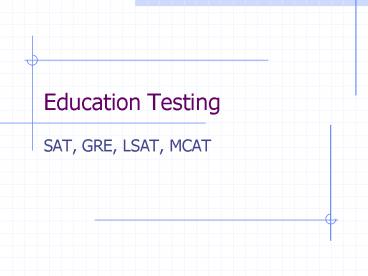Education Testing PowerPoint PPT Presentation
1 / 20
Title: Education Testing
1
Education Testing
- SAT, GRE, LSAT, MCAT
2
Individual versus Group Tests
3
Origins of Mental Testing in College Admissions
- Essay entrance exams on Latin, Greek, and Ancient
History - SAT introduced in 1920s
- Carl Brigham
- He concluded based on IQ scores that Asians and
Jews less gifted than Anglo-Saxons
4
The Scholastic Assessment Test (SAT)
- SAT I (Reasoning)
- 3 hour test of mathematical and verbal skills
- SAT II (Subject Tests)
- 1 hour test of knowledge in a subject area and
ability to apply the knowledge
5
Predictive Validity of SAT I
- Freshman GPA most frequently used criterion
- freshmen courses more similar and less variable
than at any other year in college - predictor and criterion data readily available
- freshmen grade averages highly correlated with
cumulative grade averages
6
Predictive Validity of SAT I
All tables including this one from UC and the
SAT Predictive Validity and Differential Impact
of the SAT I and SAT II at the University of
California UC Office of the President
7
Predictive Validity of SAT I
8
Predictive Validity of SAT I
9
Predictive Validity of SAT I
10
Predictive Validity of SAT I
11
Predictive Validity of SAT I
12
Predictive Validity of SAT I
13
(No Transcript)
14
Graduate Record Exam (GRE)
- General Test Verbal, Quantitative, and
Analytical Writing sections - Subject Test
- Predictive Validity
- Meta-analysis (Ingram, 1980)
- Verbal scores and GPA 25
- Quantitative scores and GPA 12.5
- Yale study
- Postgraduate First Year GPA Verbal r .17,
Quant r .29 - Veterinary students
- College GPA and Postgraduate GPA r .55
- Postgraduate GPA and Verbal r .41
- Postgraduate GPA and Quant r .47
15
Law School Admissions Test (LSAT)
- Reading comprehension, logical reasoning (½ of
the items), analytical reasoning - Electrons orbit around the nucleus of an atom the
way the earth orbits around the sun. It is well
known that gravity is a major force that
determines the orbit of the earth. We may,
therefore, expect that gravity is the main force
that determines the orbit of an electron. - The argument attempts to prove its cause by
- Applying well-known general laws to a specific
case - Appealing to well known specific cases to prove a
general law about them - Testing the conclusion by a definite experiment
- Appealing to an apparently similar case
- Stating its conclusions without giving any kind
of reason to think that it might be true
16
Law School Admissions Test (LSAT)
- Writing sample
- 6.8 "never" use the writing sample, 9.9
"always" use the sample 25.3 frequently" use
the sample 32.7 "occasionally and 25.3
reported "seldom - Can take the test up to 3 times in a two-year
period
17
Medical College Admissions Test (MCAT)
- Physical Sciences, Verbal Reasoning, Writing
Sample, Biological Sciences - Intellimetric
- Like GRE, may void score before seeing the
results - Can take it up to 3 times per year
- About 50 of those taking it use a prep service
18
Are Education Tests Biased?
- 1000 Specialists Surveyed (Snyderman Rothman,
1988) - 65 response rate
- Are tests biased against African Americans and
lower socioeconomic levels? - 2.10-2.25 (SD.8)
- 73 favored intelligence tests and aptitude tests
in hiring - 82 or more favored use of SAT, ACT, LSAT, GMAT,
MCAT, or GRE
19
Views on Detecting Test Bias
- Test bias exists if there are mean differences
(Larry P. vs. Riles, 793 F. 2d 969 (9th Cir.
1984))
20
Views on Detecting Test Bias
- Test bias exists if test systematically predicts
less accurately for individuals belonging to one
group versus another - slope bias
- SAT 1250 predicts 3.1 for majority and minority
group, but SAT of 1000 predicts 2.6 for majority
and 2.3 for minority - intercept bias
- Slopes are the same, but SAT 1250 predicts 3.1
for majority and 2.9 for minority - prediction errors differ for majority and
minority - Spread of scores around regression line differs
- SAT 1250 predicts 3.1 .4 for majority and 3.1
.9 for minority

